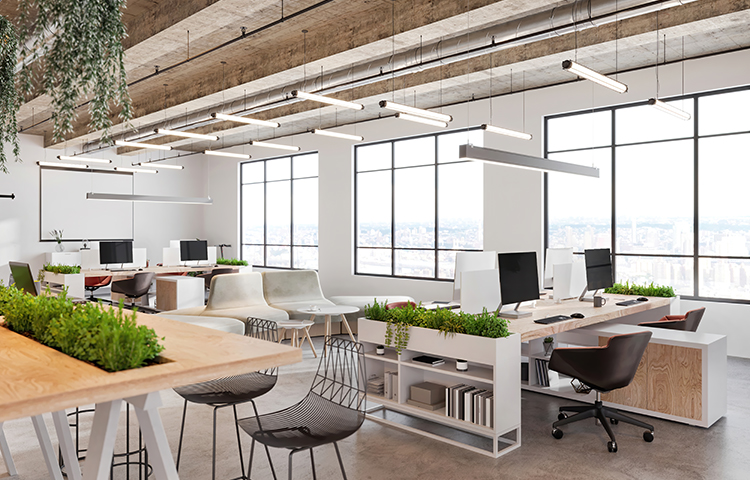Human and ‘Digital Employee’ Collaboration Will Transform Workplace Design
By Roberta Morales September 3, 2025 10:04 am
reprints
With an ever-increasing investment going toward integrating generative artificial intelligence into a seemingly infinite number of workflows, a critical question started to trickle into our conversations surrounding workplace design: “How will GenAI integration physically and culturally transform the workplace?”
As a workplace strategist with global architecture firm Gensler, I have a front-row seat to the answer.
While recent AI adoption has mostly taken place within the tidy confines of the personal computer, the effects of digital workers and AI integration will soon spill over into physical spaces, potentially reshaping individual and group culture within organizations. Recent news reports show that companies like J.P. Morgan Chase and Bank of America are investing billions in new tech initiatives, and others, like BNY, are beginning to integrate “digital employees” into their workforces. Large financial service firms are leading the charge to integrate AI into their work, and, as a result, financial services firms are likely to also lead the revolution in seamless GenAI workplace design.

Until now, banks have focused on deploying AI to optimize their workforce by, for example, utilizing GenAI assistants to support tasks typically assigned to junior bankers, such as drafting financial models, developing decks, and analyzing data with the goal of freeing humans to perform more high-touch, client-facing work. But soon (probably sooner than you think) the abilities of digital employees will grow beyond that, performing more like full-fledged employees with their own email accounts, active meeting participation, decision-making capabilities, and overall integration into hybrid digital-human workflows.
Developing effective collaboration strategies between GenAI and human employees will go hand in hand with how office spaces enable both groups to do their best work. Additionally, the level of desired collaboration between AI and humans will influence workplace requirements in the physical world.
Some questions to consider include: How do we create spaces that empower collaboration between human and GenAI employees? What sorts of new spaces can be developed to support GenAI management and development? And, perhaps most important, how can organizations support human employees in the seamless use of this emerging technology?
While we may not have the answer to everything just yet, one thing is clear: GenAI integration will lead to direct strategic shifts in workplace design. From the addition of new spaces, like GenAI training studios and innovation labs, to the adaptation of existing space types, like adding generative whiteboards to meeting rooms, GenAI integration is poised to transform how workplaces are conceptualized, designed and executed.
Starting with the floor plate, office design will shift to accommodate equipment and server densification at the building core for secure, proprietary AI systems, allowing for spaces formerly located off-site or on disconnected floors to be integrated into the workplace proper.
We’re already seeing this shift happen to “AI labs” in university contexts, where research institutes market easy access to computation power to attract top researchers. In the corporate context, tenants shopping for office space to support AI-driven innovation may prioritize buildings with wide column grids that allow flexible and modular planning to support rapid changes in technology. They may also gravitate toward some of the buildings with deep floor plates that have struggled to find tenants in recent years.
How teams are vertically stacked is also poised to change, as strategically programmed interconnectivity between human and GenAI teams prompts organizations to reconsider traditional vertical hierarchies in lieu of more integrated team arrangements. Historically, tech and engineering employees within financial services firms have largely been seen as back-of-house workers — the support behind the curtain. This status is poised to change, however, because the increasingly customer-facing nature of GenAI assistants will likely reposition tech workers to directly support revenue generation through client-facing interactions.
This shift would transform banking-focused workplaces, hierarchies and culture. One important impact this shift will have is that, in addition to competing with each other for top financial talent, banks will now likely also compete against tech giants, who already have spaces catering to tech workers’ needs, for incoming top tech talent. To maintain the competitive edge, big banks must be prepared to embrace complexity, challenge existing structures, and actively engage with the development of GenAI — harnessing its power to create a better workplace.
The spaces we use every day at work must evolve to support this transformation, and “boring” spaces that are not usually perceived as innovative, like meeting rooms and collaboration zones, are poised to be reimagined functionally and aesthetically to embrace GenAI integration.
Similarly, the amenities that support and sustain workers will likely grow in scope and specificity, as collaboration zones with large interactive displays, generative whiteboards to partner with AI, and voice input controls integrate digital and human employee work more seamlessly.
Dedicated training studios will fuel experimentation and discovery as human employees customize and train their personal AI assistants and iterate within a secure space. Innovation labs will create team-focused spaces to build and experiment using GenAI, with onboarding guides, prompt training and interactive dashboards becoming commonplace in daily work.
Not everything will be anchored by AI. In the same way that wellness and meditation rooms have taken root in modern workplaces, it is likely that organizations will create AI-free spaces and no-tech zones to allow employees to take a break from devices, if needed.
Following the pandemic-fueled remote work revolution and hybrid integration, the coming era of AI-assisted work will further blur the lines between human and AI, transforming the way we perform daily tasks, interact with colleagues, and do our work. This complex technology comes with significant challenges — and exciting opportunities to transcend the traditional boundaries of what it means to work in the office. Soon, we’ll find that while everyone may now be back in the office, they’ve brought their robots with them.
Note: This article is 100 percent human made.
Roberta Morales is a strategist in Gensler’s New York office.



